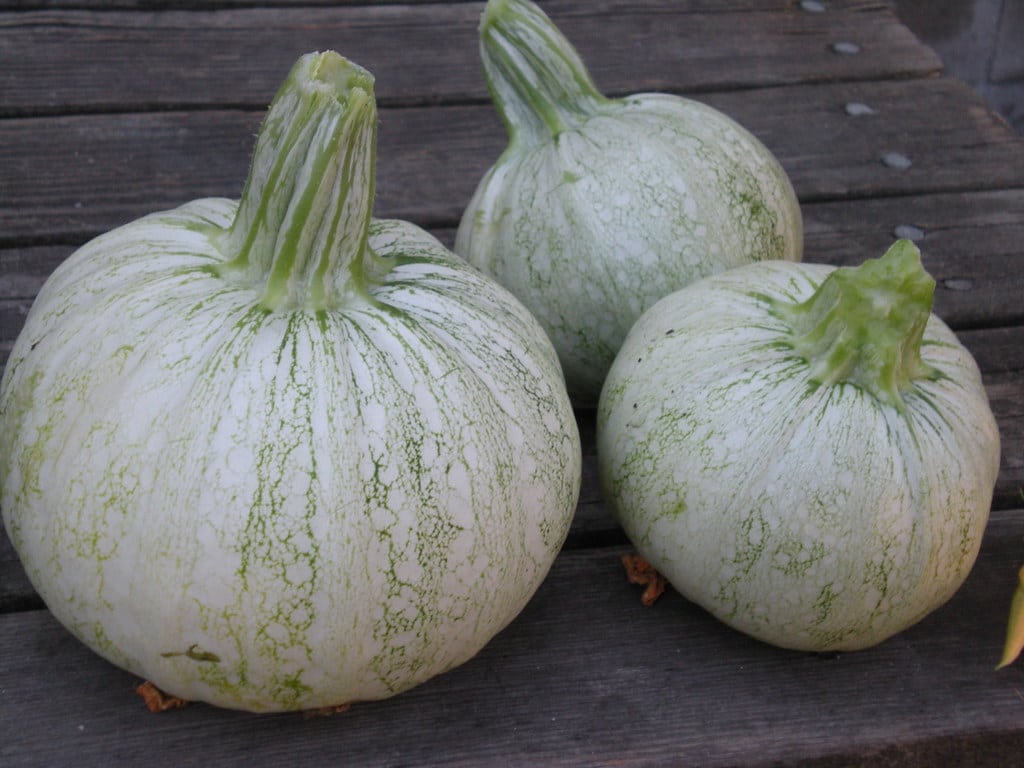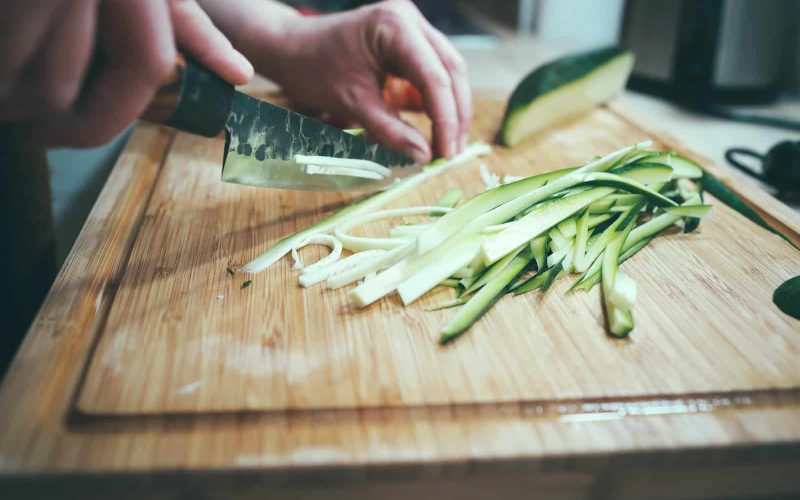When it comes to vegetables, zucchini is a classic that is loved by many.
While we’re all familiar with the traditional green-skinned variety, did you know there are so many different types of zucchini?
From unique shapes to unique colors, each type has its own unique flavor and characteristics.
In this blog post, we will explore the many different types of zucchini that you may not have known existed.
Read on to learn more!
1. Round Zucchini

Round zucchini is special among different types of zucchini found in grocery stores, and it’s easy to see why.
These round, dark green vegetables are a classic choice for making zucchini noodles, sautéing, or adding to soups.
Round zucchini is a great all-purpose vegetable that can be enjoyed raw and cooked.
This type of zucchini is a different type of zucchini with a mild flavor and subtle sweetness.
It’s also low in calories and packed with essential vitamins and minerals. When selecting round zucchini, look for firm, dark green fruits with glossy skin.
Avoid fruits with soft spots or discoloration, as this could indicate the fruit is overripe.
2. Long Zucchini
Long zucchini, also known as tromboncino or serpente squash, is a variety of summer squash that has a unique shape.
Long zucchini tend to be much longer than regular zucchini, with a slightly curved neck at one end. They often reach lengths of up to 18 inches, although some can grow even longer.
Squash is another option among different types of zucchini that can be eaten in the same way as other varieties, including baked, grilled, or sautéed.
Their mild flavor pairs well with a variety of sauces and seasonings. Long zucchini can also be sliced and fried for a delicious side dish.
3. Crookneck Zucchini
Crookneck zucchini is a variety of summer squash with a curved neck and bright yellow skin.
Its flesh is firm and slightly sweet, making it a great choice for grilling, roasting, sautéing, or adding to stir-fries.
Crookneck zucchini is generally available year-round, but its peak season is late summer.
This type of squash is unique among different types of zucchini. It has many health benefits, including a high vitamin content, which helps to boost immunity and protect against oxidative stress.
It also contains folate, which aids in cell growth and development.
In addition, crookneck zucchini contains dietary fiber and iron, both of which are important for maintaining a healthy digestive system.
When selecting crookneck zucchini, look for specimens that are firm and have smooth, evenly colored skins.
Avoid zucchini with any signs of softness or bruising. Store uncut zucchini in the refrigerator for up to five days. For best results, cook crookneck zucchini soon after purchase.
4. Golden Zucchini
Golden zucchini is another unique and special among different types of zucchini of summer squash with yellow or orange skin and edible seeds.
The flesh of the vegetable is often yellow but can also have green streaks throughout. It has a mild flavor and a tender texture.
Golden zucchini can be eaten raw or cooked and used in various dishes. Raw golden zucchini can be grated and added to salads, while cooked golden zucchini can be roasted, grilled, steamed, stir-fried, or baked. It can also be stuffed with fillings and served as a main dish.
Golden zucchini pairs well with garlic, olive oil, lemon, herbs, and spices. For a quick and healthy snack, slices of golden zucchini can be dipped in hummus or other dips for a tasty treat.
5. Ronde de Nice
Ronde de Nice is a unique type of zucchini that originated in the French Riviera. It has a bright green color and a round shape, hence its name.
The flesh of the zucchini is another type among different types of zucchini with firm and flavorful, making it an excellent choice for roasting or grilling.
It’s also great for making zucchini noodles, casseroles, salads, soups, and stews. When harvested young, this variety of zucchini is particularly sweet and tender.
Ronde de Nice is best eaten fresh, as it will lose some of its flavor and texture when cooked. With its delightful taste and versatility, this type of zucchini is sure to be a favorite among home cooks!
6. Costata Romanesco
Costata Romanesco is a unique zucchini species identifiable by its distinctive ridged, ribbed green skin.
It is typically larger than the standard green zucchini, growing up to six inches in length and three inches in diameter.
The name Costata Romanesco comes from its costato, or ribbed, shape.
Costata Romanesco zucchinis are usually harvested when they are still immature and small, between four and five inches long.
The taste of these different types of zucchini variety is sweet, succulent and slightly nutty.
Costata Romanesco has a creamy texture with a delicate flavor and crunchy bite, making it perfect for salads, soups, pasta dishes, roasting and grilling.
Due to its size and shape, Costata Romanesco makes an attractive presentation on the plate.
Its unique ridges make it ideal for stuffing with fillings or slicing into thin ribbons for salads or other dishes.
With its high moisture content, this variety is perfect for steaming and can be added to any stew or soup for added texture and flavor.
Costata Romanesco is a great choice for home gardeners looking for something different in their zucchini harvest.
Its long shelf life and storage potential make it a great addition to any kitchen pantry.
7. Tromboncino
Tromboncino is another type of different types of zucchini that has a long, curved shape that looks like a trombone.
The exterior of the squash is usually pale green in color, but it can also be yellow or white.
It grows up to two feet in length and is typically harvested when it is still immature.
It has a mild, sweet flavor and is often used in soups and casseroles. It can also be sliced and cooked in stir-fries and salads.
Tromboncino is a great way to add variety to your meals. Its shape makes it perfect for stuffing, grilling, or roasting. You can also sauté them and serve them with pasta or rice.
If you’re looking for a healthy side dish, try slicing it into coins and lightly frying it in olive oil.
For a twist on the classic zucchini bread, try adding Tromboncino squash instead of zucchini for an unexpected flavor.
8. Cocozelle
Cocozelle is a type of zucchini with striped, dark green skin. Its flesh is a light green color with white stripes.
The zucchini is more cylindrical than round and can grow up to eight inches in length.
It is considered one of the best-tasting zucchini varieties because of its sweet flavor.
Cocozelle is an heirloom variety of zucchini that has been around for a long Tim Cocozelle is easy to grow and requires little maintenance, making it a favorite of many home gardeners.
This is another type of zucchini that grows quickly and produces large yields with proper care.
Cocozelle is a summer squash that can be eaten raw, cooked or added to salads, soups, and other recipes.
It is a great choice for anyone looking to add unique flavor to their dishes.
9. All Green Bush Zucchini
All Green Bush Zucchini is another type among different types of zucchini. It is a round, medium-sized zucchini with smooth, glossy dark green skin and light green flesh. The flavor is mild, and the texture is quite firm.
This type of zucchini is perfect for all sorts of dishes, such as salads, soups, stews, casseroles, stir-fries and more.
You can also eat it raw in slices, cubes or even grated. It is best harvested when it is still small and tender.
As it matures, the skin gets tougher, and the flavor can become slightly bitter. If you want to store All Green Bush Zucchini, you should place it in a cool and dry area for up to two weeks.
10. Bianco di Trieste
Bianco di Trieste is a type of zucchini that originated in Italy. It is a variety of summer squash, which is popular for its creamy white skin and mild flavor. It is cylindrical in shape, with slightly curved sides and a pointed end.
The flesh is thick and juicy, and the seeds are easily removed. Bianco di Trieste is often used in soups and stews or sautéed in olive oil.
When cooked, these different types of zucchini has a subtle flavor with a hint of sweetness.
It is also perfect for grilling or baking into pieces of bread and desserts. The best way to pick out a fresh Bianco di Trieste is to look for an unblemished skin and firm flesh.
Store it in the refrigerator, which will keep it for up to two weeks.
11. Black Beauty
Black Beauty is a variety of zucchini that is dark green with white stripes, giving it a distinctive look.
It is one of the different types of zucchini with popular varieties of zucchini and is considered to have a sweeter flavor than other types.
Black Beauty has a deep color, uniform shape, and tender texture, making it great for eating raw, steaming, sautéing, grilling, or stuffing.
This type of zucchini also grows relatively quickly and can be harvested. Because of its unique taste, Black Beauty is a favorite among gardeners and cooks alike.
12. Caserta
Caserta is another type among different types of zucchini that is known for its long, slender shape and bright green skin.
The flesh inside the fruit is a pale yellow-green and has a mild, sweet flavor. It is most often used in raw salads or lightly cooked recipes.
The Caserta zucchini can be harvested while still young, tender, or left on the vine to grow larger.
When harvesting young zucchinis, make sure to remove all of the stems and blossom ends before storing them.
Caserta zucchini can also be frozen and used in recipes at a later time. This variety of zucchini is popular in Mediterranean dishes and adds great flavor and texture to any recipe.
13. Crookneck Squash
Crookneck squash is a type of zucchini, but it has a curved neck and a smoother texture than regular zucchini.
It is also slightly sweeter than the traditional green variety. Crookneck squash is a type of zucchini, which refers to vegetables harvested while immature and their skin is still tender.
It can be harvested at various stages of maturity, ranging from small finger-sized fruit to larger neck-shaped squash.
This type of squash is best eaten when young and tender, as the flesh becomes tougher with age. It has a mild, almost sweet flavor and is most often cooked.
It can be used in many recipes that call for zucchini, such as casseroles, soups, stews, and stir-fries.
It can also be grilled, roasted, stuffed, or baked. The yellow rind of the squash may be peeled before cooking if desired.
When selecting crookneck squash, look for ones that are firm and bright in color with no blemishes. Avoid squash that is soft or discolored. Store in a cool, dry place for up to a week.
14. Dunja
Dunja is a type of zucchini that originated in Serbia. It has light yellow-green skin with an oblong shape.
The Dunja variety is considered one of the tastiest zucchini varieties and has an exceptionally sweet flavor.
This type of zucchini, among different types of zucchini is excellent for both baking and steaming, making it a versatile ingredient in many dishes.
Dunja zucchini are known for their high yield and are often picked earlier than other varieties. This type of zucchini can be eaten fresh, pickled, or canned.
15. Gadzukes
Gadzukes, also known as Acorn squash, is one of the different types of zucchini.
This variety is native to South America and has a distinctive shape that looks like an acorn or bell.
The skin of the Gadzuke is smooth and dark green in color with yellowish or white streaks. It has a hard, edible flesh that is sweet, nutty, and slightly bitter.
They can range in size from one to five pounds. Gadzukes have a high level of nutrients, including Vitamin A, potassium, calcium, magnesium, phosphorus, and dietary fiber. They are also low in calories and carbohydrates.
This makes them a great choice for those looking for a healthy vegetable. They can be roasted, boiled, or grilled and can be eaten as a side dish or added to salads and soups.
To bring out the flavor, some people like to season them with garlic or herbs. Gadzukes are versatile vegetables that can be enjoyed in many different dishes.
16. Magda
Magda zucchini is an heirloom variety of summer squash originating from the Mediterranean region.
These different types of zucchini have dark green skin, yellow spots, and a white or light-greenish flesh. It has a smooth texture and a sweet flavor.
The zucchini size can vary from two to four inches in length, but the average size is around three inches.
It is known for its tenderness and is often used as an alternative to other squash varieties.
Magda is best eaten when it is young and tender; when the skin turns yellow and waxy, it is usually past its peak.
Magda zucchini is perfect for roasting, grilling, baking, and stuffing. It is also a great addition to soups, stews, and salads.
When harvesting Magda zucchini, you should look for fruits that are still firm to the touch and have no blemishes or bruises on their skin.
17. Nero de Milano
The skin of the Nero de Milano can be eaten when it is still young and tender.
As it matures, the skin becomes thicker and tougher and should be peeled off before eating. It can be used in various dishes, from soups and stews to salads and stir-fries.
Nero de Milano zucchini is another type among different types of zucchini. It has a dark, glossy exterior with faint stripes or speckles in various shades of green.
The shape is also unique; it is long and slender with an elongated neck, resembling an eggplant. It has a creamy, mild flavor with a firm texture and few seeds.
Its thin walls make it ideal for stuffing and baking. This type of zucchini is most commonly found in specialty stores, farmer’s markets, and larger grocery stores.
18. Pattypan Squash
Pattypan squash, also known as scallop squash, is a different types of zucchini that comes in several varieties.
Its name comes from its shape, which resembles a scallop shell. This type of zucchini has a slightly nutty flavor, and it’s best cooked when it’s young and tender.
The most common variety of pattypan squash is the yellow-green Sunburst.
It has thick, dark green skin, and its flesh is yellow-green with dark seeds. There is also a white variety of pattypan squash called White Scallop.
It has smooth skin and can be eaten raw or cooked. Pattypan squash is a great addition to many dishes. It can be grilled, roasted, stuffed, sautéed, or added to stir-fries.
It can also be used as an alternative to pasta in lasagna or other casseroles.
Pattypan squash can be served as a side dish with seasonings like herbs, garlic, and lemon juice. Or use it to make zucchini soup or pasta salad.
No matter how you cook with pattypan squash, you’ll surely enjoy its unique flavor and texture.
19. Rampicante Zucchini
Rampicante zucchini, sometimes called climbing zucchini, is a vining type of zucchini with long, slender fruits.
The fruits are usually picked when they are young and tender while they are still in the shape of a cylinder.
The flavor of rampicante zucchini is similar to other types of zucchini, with a slightly sweet taste.
These different types of zucchini is perfect for growing in containers, as it does not require much space. It also grows quickly, producing fruits in as little as 45 days.
This makes it an ideal choice for home gardeners looking for a fast-growing plant that yields abundant fruit.
Rampicante zucchini can be cooked in various ways, including grilling, roasting, baking, and sautéing. It can also be eaten raw, either sliced or grated into salads.
This type of zucchini is also popularly used in soups and stews. When storing this type of zucchini, it is best to keep it in the refrigerator.
20. Tromboncino Zucchini
Tromboncino Zucchini, also known as serpente or Italian squash, is an heirloom variety of summer squash that is popular in Italy.
Tromboncino is a type of zucchini with a mild flavor and is highly versatile; it can be used in many dishes, such as casseroles, soups, and pasta dishes.
The distinctive shape of the tromboncino resembles a trumpet with its long, curved neck, and its texture is firm yet tender.
When selecting a tromboncino zucchini, look for bright green and firm ones to the touch.
They should have no brown spots or bruises and should be as long as possible for the best quality. Tromboncino can be stored in the refrigerator for up to two weeks.
Tromboncino zucchini can be prepared in various ways, including roasted, grilled, sautéed, and steamed.
It’s best to slice them into thin strips or rounds for stir-fries and sautés. To roast tromboncino zucchini, preheat your oven, cut the zucchini into thick slices, coat with olive oil and seasonings of your choice, and bake until lightly browned.
Tromboncino zucchini is a great addition to any meal because it adds flavor and texture to dishes.
Plus, it’s a healthy vegetable packed with vitamins and minerals such as vitamin A, potassium, iron, and magnesium.
Add this unique summer squash to your next meal, and you won’t be disappointed!
21. Zucchini Flowers
Zucchini flowers are a delicious and nutritious addition to your meals! These yellow blossoms are edible, with a sweet and slightly bitter flavor.
They’re typically found in the summertime when zucchini are in season. The flowers are often fried or stuffed and can be served as appetizers, side dishes, or even added to salads.
Zucchini flowers are different types of zucchini packed with vitamins and minerals such as potassium and iron.
Plus, they contain lots of antioxidants that help keep your body healthy. While zucchini flowers are generally considered safe to eat, it’s best to double-check with a nutritionist before consuming them to ensure they’re not harmful to your health.
Zucchini flowers are also a great source of fiber, which can help promote digestion and lower cholesterol.
So next time you spot some of these beautiful blooms in the summer months, why not try them?
Conclusion
Zucchini is an incredibly versatile and delicious vegetable that is suitable for a variety of dishes.
With so many different types of zucchini, there’s sure to be one that’s perfect for your next meal.
From the classic round, long, and crookneck varieties to more unique types like Ronde de Nice, Costata Romanesco, and Tromboncino, you can explore the flavors and textures of zucchini in new and exciting ways.
So next time you’re at the grocery store, don’t be afraid to give some of these less familiar types of zucchini a try!








